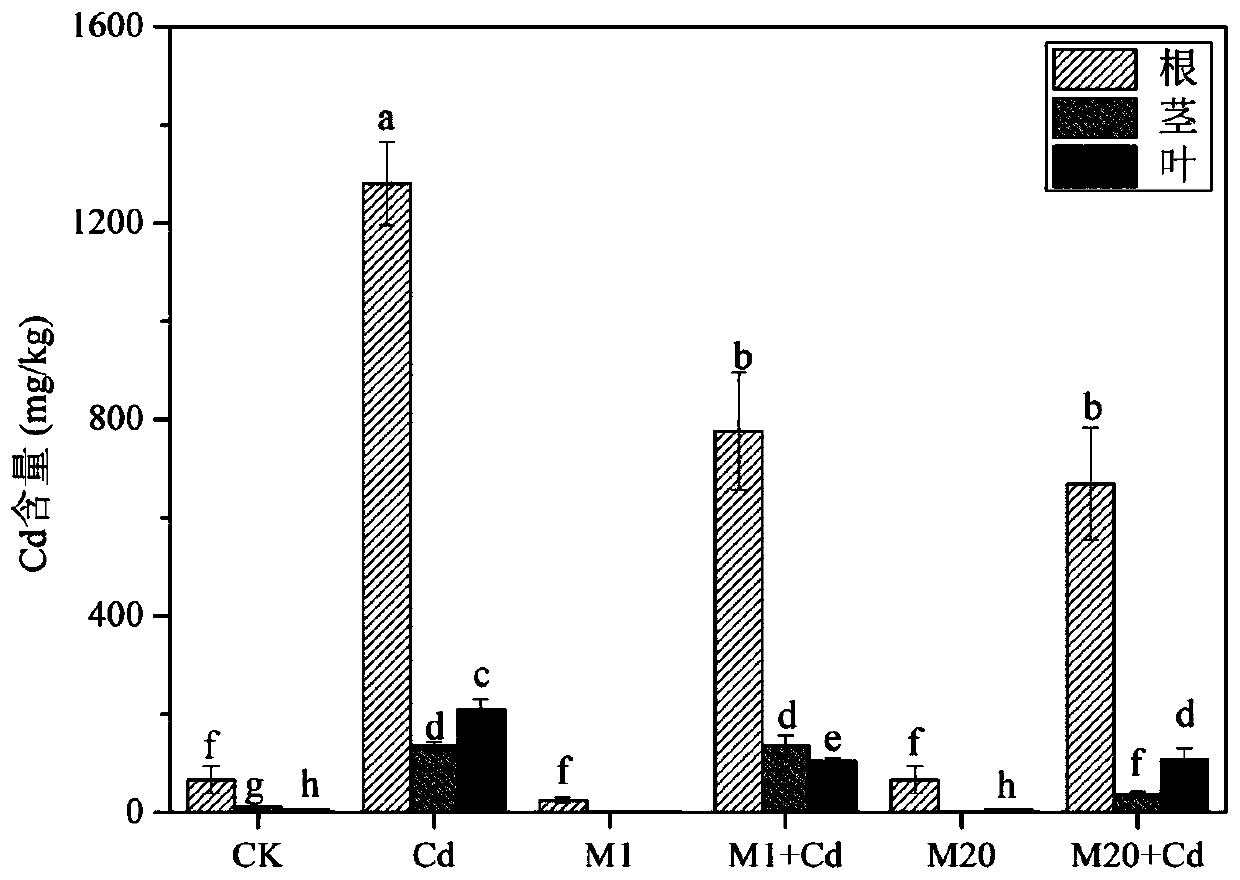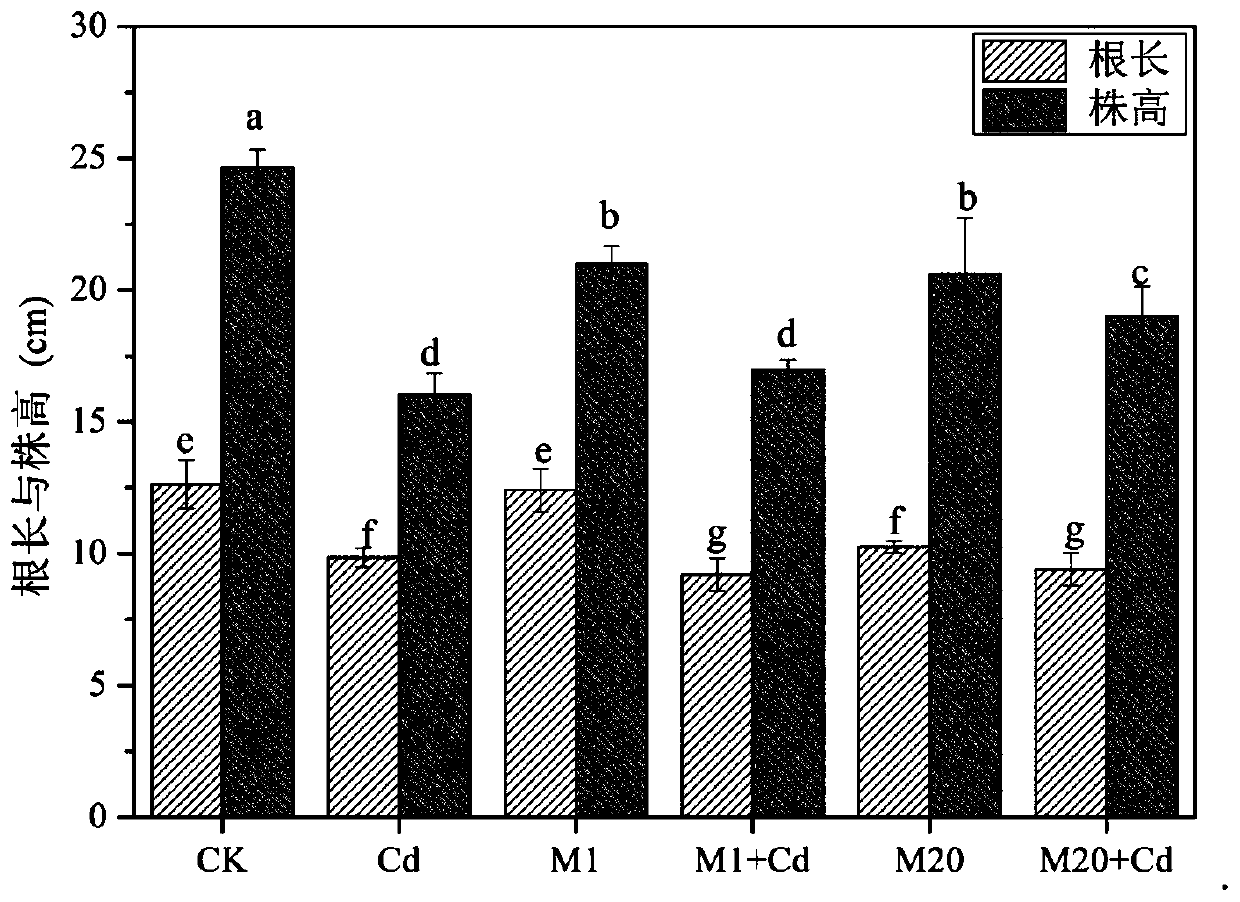Water-culture method for relieving toxic action of cadmium on tomatoes by virtue of methyl jasmonate and application of methyl jasmonate
A tomato and hydroponic technology, applied in the application of MeJA, in the hydroponic field where MeJA alleviates the toxic effect of Cd on tomato, can solve problems such as lack of thorough research, threats to the health of the people, and impact on the annual income of the tomato industry, and achieves alleviation, inhibition, Growth-promoting effect
- Summary
- Abstract
- Description
- Claims
- Application Information
AI Technical Summary
Problems solved by technology
Method used
Image
Examples
Embodiment 1
[0043] Choose tomato seeds with the same size and full grains (purchased from Xinjiang Shihezi Vegetable Research Institute), disinfect them with 3% sodium hypochlorite for 15 minutes, and then rinse them with distilled water until they are odorless. Then put the tomato seeds evenly in the tray with vermiculite, and sprinkle a thin layer of vermiculite on the surface of the seeds to prevent germination from light, add appropriate amount of water to the bottom of the tray and seal the plug with plastic wrap. Tear off the plastic wrap when cultivating in the artificial culture room until germination, and transfer the tomato to the hydroponic box containing 1 / 2 of the Hoagland nutrient solution when it grows to two leaves and one heart, and place it in the automatic control growth room for cultivation ( 15-17 hours of light, 7-9 hours of darkness, relative humidity of 55% to 65%, daytime temperature of 24°C to 28°C, night temperature of 18°C to 22°C). After three weeks of hydro...
Embodiment 2
[0084] Choose tomato seeds with the same size and full grains (purchased from Xinjiang Shihezi Vegetable Research Institute), disinfect them with 3% sodium hypochlorite for 15 minutes, and then rinse them with distilled water until they are odorless. Then put the tomato seeds evenly in the tray with vermiculite, sprinkle a thin layer of vermiculite on the surface of the seeds, avoid light to germinate, add appropriate water to the bottom of the tray and seal the plug with plastic wrap. Tear off the plastic wrap when cultivating in the artificial culture room until germination, and transfer the tomato to a hydroponic box containing 1 / 2 of the Hoagland nutrient solution when it grows to two leaves and one heart, and place it in an automatic control growth room for cultivation ( 15-17 hours of light, 7-9 hours of darkness, relative humidity of 55% to 65%, daytime temperature of 24°C to 28°C, night temperature of 18°C to 22°C). After three weeks of hydroponic cultivation, select...
Embodiment 3
[0088]Choose tomato seeds with the same size and full grains (purchased from Xinjiang Shihezi Vegetable Research Institute), disinfect them with 3% sodium hypochlorite for 15 minutes, and then rinse them with distilled water until they are odorless. Then put the tomato seeds evenly in the tray with vermiculite, sprinkle a thin layer of vermiculite on the surface of the seeds, avoid light to germinate, add appropriate water to the bottom of the tray and seal the plug with plastic wrap. Tear off the plastic wrap when cultivating in the artificial culture room until germination, and transfer the tomato to a hydroponic box containing 1 / 2 of the Hoagland nutrient solution when it grows to two leaves and one heart, and place it in an automatic control growth room for cultivation ( 15-17 hours of light, 7-9 hours of darkness, relative humidity of 55% to 65%, daytime temperature of 24°C to 28°C, night temperature of 18°C to 22°C). After three weeks of hydroponic cultivation, select ...
PUM
 Login to View More
Login to View More Abstract
Description
Claims
Application Information
 Login to View More
Login to View More - R&D
- Intellectual Property
- Life Sciences
- Materials
- Tech Scout
- Unparalleled Data Quality
- Higher Quality Content
- 60% Fewer Hallucinations
Browse by: Latest US Patents, China's latest patents, Technical Efficacy Thesaurus, Application Domain, Technology Topic, Popular Technical Reports.
© 2025 PatSnap. All rights reserved.Legal|Privacy policy|Modern Slavery Act Transparency Statement|Sitemap|About US| Contact US: help@patsnap.com



